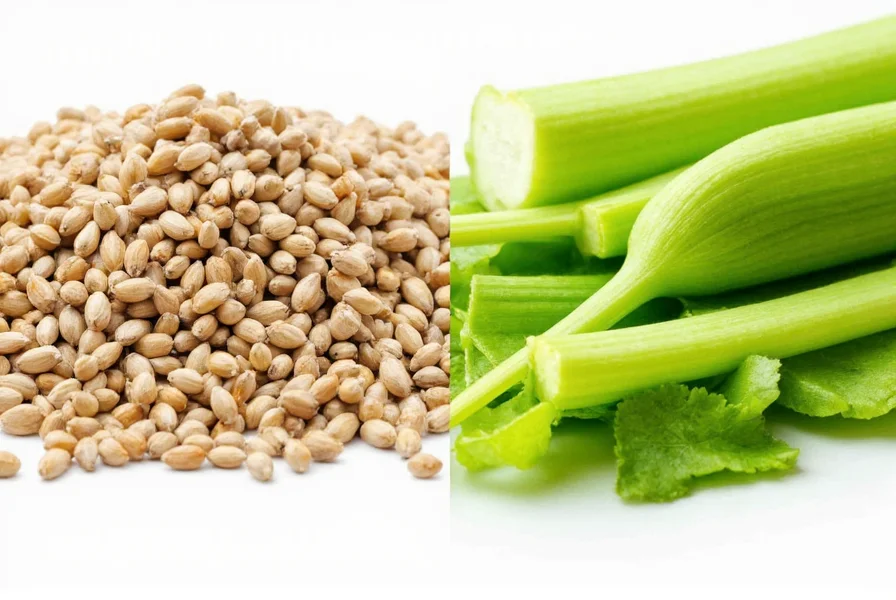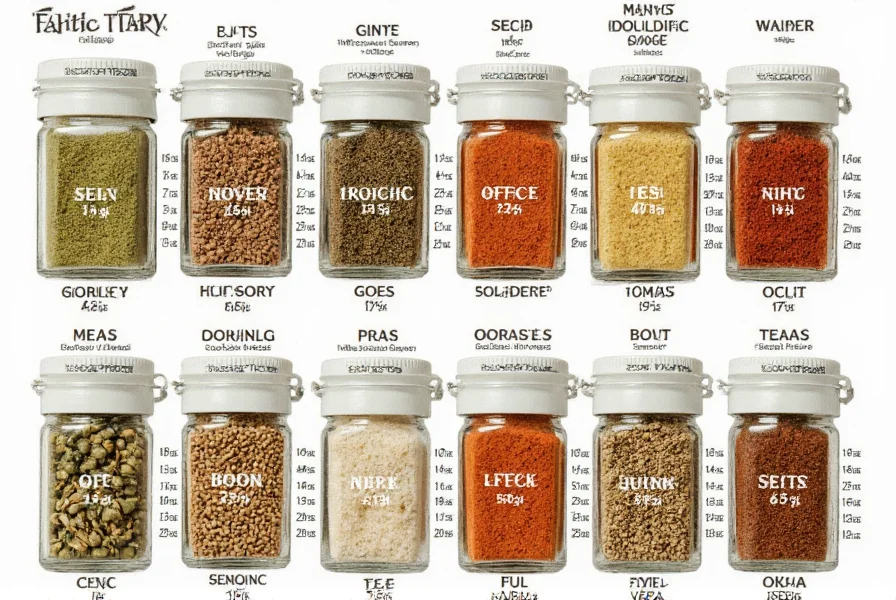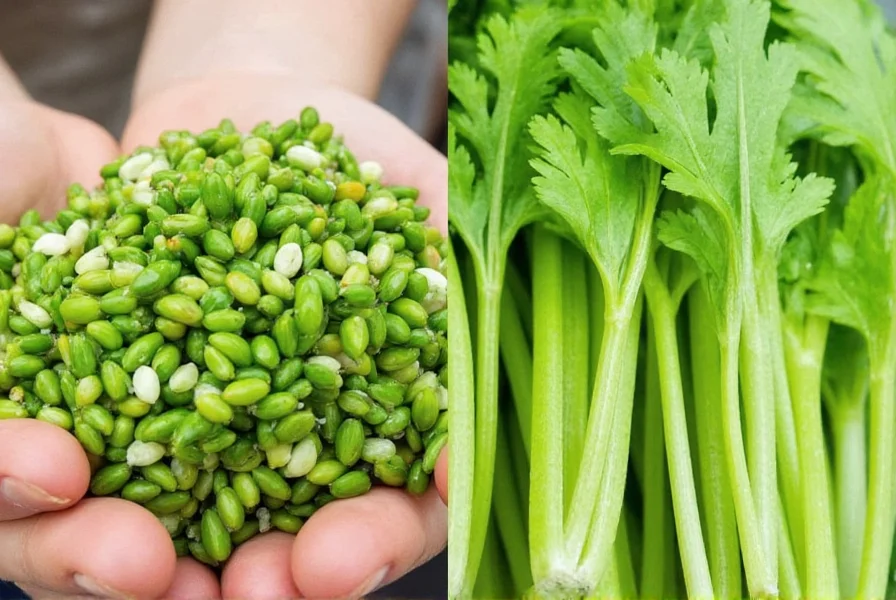When your recipe calls for celery seed but your spice cabinet comes up empty, knowing the right substitution can save your dish. Celery seeds have a distinctive flavor—earthy, slightly bitter, with a hint of parsley and lemon—that's challenging to replicate exactly. However, several alternatives can maintain your recipe's integrity when used correctly.
Understanding Celery Seed's Flavor Profile
Celery seeds come from the same plant as the celery stalks we eat, but they're harvested from the flowering plant Apium graveolens. These tiny seeds pack a concentrated flavor that's more intense than fresh celery, with warm, herbal notes and subtle bitterness. They're commonly used in:
- Pickling brines and relishes
- Cole slaw dressings
- Soups and stews
- Salad dressings and marinades
- Seasoning blends like Old Bay
Top Celery Seed Substitutes with Measurements
Choosing the right celery seed replacement depends on your specific recipe and what ingredients you have available. Here are the most effective alternatives with precise conversion ratios:
| Substitute | Conversion Ratio | Best For | Flavor Notes |
|---|---|---|---|
| Celery salt | 1/4 tsp per 1 tsp celery seed | Dressings, soups, potato salad | Similar flavor but adds salt—reduce other salt in recipe |
| Fresh celery | 2 Tbsp minced stalk per 1 tsp seed | Soups, stews, casseroles | Milder flavor, adds texture and moisture |
| Lovage | 1/2 tsp dried or 1 Tbsp fresh per 1 tsp seed | Pickling, stocks, dressings | Celery-like but more intense; use sparingly |
| Dill seeds | 1:1 replacement | Pickling, coleslaw, potato salad | Slightly different profile but works well in similar applications |
| Fennel seeds | 1/2 tsp per 1 tsp celery seed | Soups, roasted vegetables, fish dishes | Sweeter, licorice-like note; best for non-pickling applications |
Celery Salt: The Most Accessible Substitute
For quick celery seed replacement in recipes, celery salt is often the most convenient option since many kitchens already have it. Remember that celery salt is typically a 3:1 salt-to-celery-seed ratio, which is why you need to use less. When substituting celery salt for celery seed:
- Use 1/4 teaspoon celery salt for every 1 teaspoon of celery seed called for
- Reduce additional salt in your recipe by 1/4 teaspoon per substitution
- Best for dressings, soups, and potato salad where the salt content can be adjusted
This celery seed alternative works particularly well in coleslaw recipes and tuna salads where the celery flavor is important but exact measurements aren't critical.
Fresh Celery: For Texture and Milder Flavor
When you need a celery seed replacement in recipes where texture matters, fresh celery provides both flavor and crunch. Two tablespoons of finely minced celery stalk equals approximately one teaspoon of celery seed. This substitution works best in:
- Hot dishes like soups and stews where the celery will cook down
- Salads where you want visible celery pieces
- Recipes where moisture content isn't critical
For the best results, use the inner stalks which are more tender and flavorful. If your recipe specifically calls for the concentrated flavor of celery seed (like in pickling), fresh celery won't provide the same intensity.

Lovage: The Professional Chef's Secret
Lovage offers the closest flavor match to celery seed but is less common in home kitchens. This herb has a more intense celery flavor, so use it sparingly. For celery seed substitution measurements:
- Dried lovage: Use half the amount of celery seed called for
- Fresh lovage: Chop leaves finely and use double the amount of celery seed
Lovage works exceptionally well as a celery seed alternative for soup recipes and stocks. If you're growing herbs, consider adding lovage to your garden—it's a perennial that comes back year after year and makes an excellent celery seed replacement when dried.
Dill Seeds: The Pickling Specialist
When looking for the best substitute for celery seed in pickling recipes, dill seeds provide a similar texture and complementary flavor. Use dill seeds in a 1:1 ratio for celery seeds in:
- Pickled vegetables
- Cole slaw dressings
- Salmon or fish dishes
While dill has a distinct flavor profile, it works well in the same applications as celery seed. This makes it one of the most practical celery seed replacement options for preserving vegetables. The seeds look nearly identical, so your pickles will maintain their expected appearance.
Fennel Seeds: For Complex Flavor Profiles
Fennel seeds offer a different but complementary flavor that works well as a celery seed substitute in certain applications. Use half the amount of fennel seeds compared to celery seed because:
- Fennel has a stronger, slightly sweet anise flavor
- It can overpower dishes if used in equal amounts
- The texture is similar but the flavor profile differs
This celery seed alternative shines in Mediterranean dishes, roasted vegetables, and fish preparations. Avoid using fennel seeds as a celery seed replacement in American-style coleslaw or potato salad, where the flavor profiles would clash.
Special Considerations for Specific Recipes
Different dishes require different approaches to celery seed substitution:
Pickling Recipes
For the best substitute for celery seed in pickling, dill seeds are your top choice. They provide similar visual appeal and work well with vinegar-based brines. If making bread and butter pickles, you can also try a combination of mustard seeds and a pinch of dried dill weed.
Cole Slaw Dressings
When you need celery seed replacement in recipes like coleslaw, celery salt works well but remember to adjust salt content. For a salt-free option, finely minced fresh celery provides both flavor and texture. Some chefs recommend adding a pinch of celery seed substitute like dried parsley flakes for extra depth.
Soup and Stew Applications
For celery seed substitute measurements in hot dishes, fresh celery is ideal. Add it early in the cooking process to allow flavors to meld. If you're making a clear broth where visible celery pieces would be undesirable, try a small amount of celery juice or a dash of celery salt.

Common Substitution Mistakes to Avoid
Even with the right celery seed replacement, these common errors can ruin your dish:
- Using equal amounts of celery salt—this will make your dish overly salty
- Substituting celery seed with celery root (celeriac)—they have different flavor profiles
- Using too much fennel seed—its strong anise flavor can dominate
- Adding fresh celery too late in cooking—it needs time to release its flavor
- Ignoring recipe context—pickling requires different substitutes than baking
Creating Your Own Celery Seed Blend
If you frequently need celery seed replacement in recipes, consider making a homemade celery seed blend. Combine:
- 2 parts dried parsley
- 1 part dried dill weed
- 1/2 part dried thyme
- Pinch of asafoetida (optional, for umami)
Store in an airtight container for up to six months. This blend works well as a celery seed substitute measurements guide for most savory applications, though it won't replicate the exact flavor.
FAQ: Celery Seed Substitution Questions
Can I use celery salt instead of celery seed in pickling?
Yes, but with caution. Use 1/4 teaspoon celery salt for every 1 teaspoon of celery seed called for, and reduce additional salt in your recipe by the same amount. For optimal pickling results, dill seeds make a better 1:1 replacement as they won't affect the brine's salt concentration.
What's the best celery seed substitute for someone on a low-sodium diet?
Fresh celery is the best low-sodium celery seed replacement. Use 2 tablespoons of finely minced inner celery stalks per teaspoon of celery seed. Lovage (1 tablespoon fresh per teaspoon of seed) is another excellent sodium-free option with a more concentrated flavor.
How do I substitute fresh celery for celery seed in baking?
In baking applications, fresh celery isn't ideal as a celery seed substitute because of its moisture content. Instead, use dried celery flakes (2 teaspoons per 1 teaspoon of seed) or a small amount of celery powder. For bread recipes specifically, consider using a combination of fennel seeds (1/4 teaspoon) and dried parsley (1/2 teaspoon) per teaspoon of celery seed.
Can I use ground celery instead of celery seeds?
Yes, ground celery makes an excellent 1:1 replacement for celery seeds. It has the same flavor profile but distributes more evenly throughout dishes. Use the same measurement as celery seeds, but add it later in the cooking process as ground spices lose potency faster than whole seeds.
What's the difference between celery seed and celery flakes?
Celery seed comes from the plant's flowers and has a more concentrated, slightly bitter flavor. Celery flakes are made from dehydrated celery stalks and have a milder taste. When substituting, use 2 teaspoons of celery flakes for every 1 teaspoon of celery seed. Celery flakes work better in soups and stews, while celery seeds are preferred for pickling and dressings.











 浙公网安备
33010002000092号
浙公网安备
33010002000092号 浙B2-20120091-4
浙B2-20120091-4